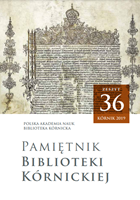PORTRETY ALBRECHTA PRUSKIEGO I KSIĘŻNEJ DOROTY NA OPRAWIE ZE ZBIORÓW BIBLIOTEKI KÓRNICKIEJ. Z BADAŃ NAD IKONOGRAFIĄ WŁADCÓW W RENESANSOWYM ZDOBNICTWIE INTROLIGATORSKIM
PORTRAITS OF ALBRECHT OF PRUSSIA AND DUCHESS DOROTHEA ON A BINDING KEPT AT THE KÓRNIK LIBRARY. FROM RESEARCH INTO THE ICONOGRAPHY OF RULERS IN RENAISSANCE BOOK BINDING DECORATIONS
Author(s): Arkadiusz WagnerSubject(s): Cultural history, Museology & Heritage Studies, Visual Arts, Archiving, Social history, 16th Century, Sociology of Art, History of Art
Published by: Biblioteka Kórnicka PAN
Keywords: Prussian bookbinding in the 16th century; 16th century Konigsberg (Kaliningrad); Albrecht von Hohenzollern (1490–1568); Dorothea of Denmark (1504–1547); Jan Seklucjan (d. 1578) – theologian; Lutheran
Summary/Abstract: The collections of the Kórnik Library of the Polish Academy of Sciences include a set of printed textes by Jan Seklucjan with a handwritten dedication to Albrecht Frederick, Duke of Prussia (†1618). Their binding is decorated with plaquettes with portraits of Albrecht von BrandenburgAnsbach, Duke of Prussia (†1568) and his first wife Dorothea (†1547). The article analyses both compositions, providing the following conclusions: they were made in the Konigsberg circles of the so-called Formschneider between the end of the 1530s and the first half of the 1540s. Between the period in question and 1565, wooden plaquettes (blocks) with these portraits were kept by the Duke’s court bookbinder, Kaspar Angler. After his death they probably belonged to the workshop equipment of his pupil Wolff Artzt, although it is also possible that they were used by a local religious writer, bookseller and possibly also bookbinder – Jan Seklucjan. Both works are examples of adaptation in Konigsberg of a specific formula of Renaissance book binding decoration, being at the same time a bookplate, based on a rectangular portrait plaquette presented in the centre of the cover. Compositions of such works most often depended on the painted portraits – mainly from the workshop of Lucas Cranach the Elder. Both Konigsberg portraits, however, are marked by prolonged proportions, a landscape background, and the display of coats of arms at the bottom. This fact should be explained by the painting models that were probably related to paintings in Albrecht’s Konigsberg residence. It is impossible to decide definitely whether they were made by a painter employed at his court (e.g. Crispin Herrant), or imported. Nevertheless, they are an indirect testimony to the existence of a gallery of portraits in the Konigsberg Castle, which was created on a long-term basis and with passion by the Duke of Prussia.
Journal: Pamiętnik Biblioteki Kórnickiej
- Issue Year: 2019
- Issue No: 36
- Page Range: 99-122
- Page Count: 24
- Language: Polish

